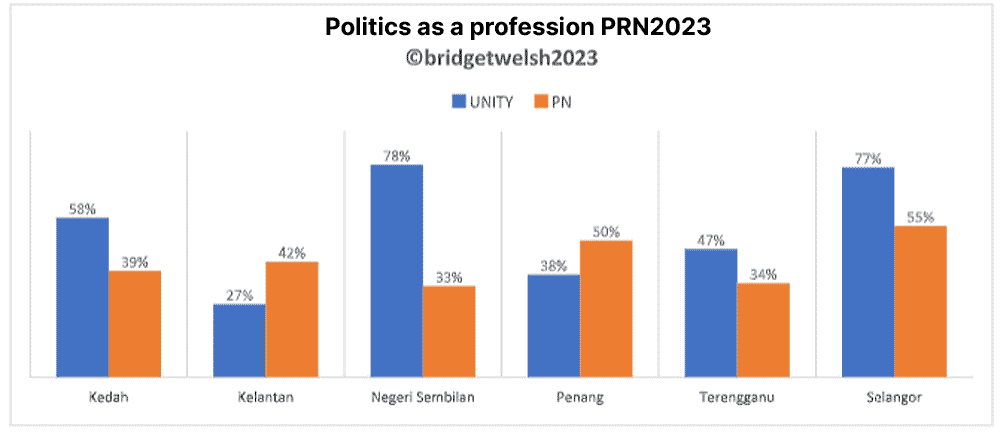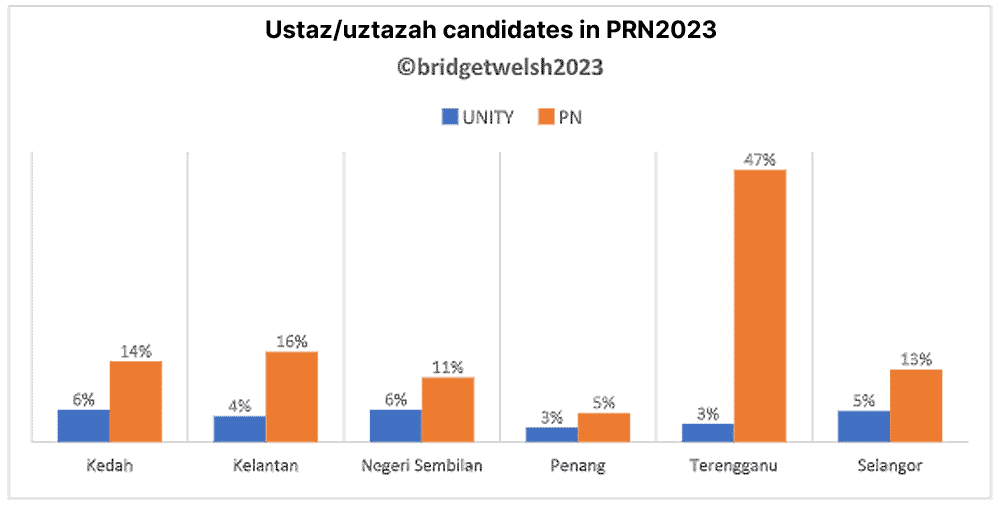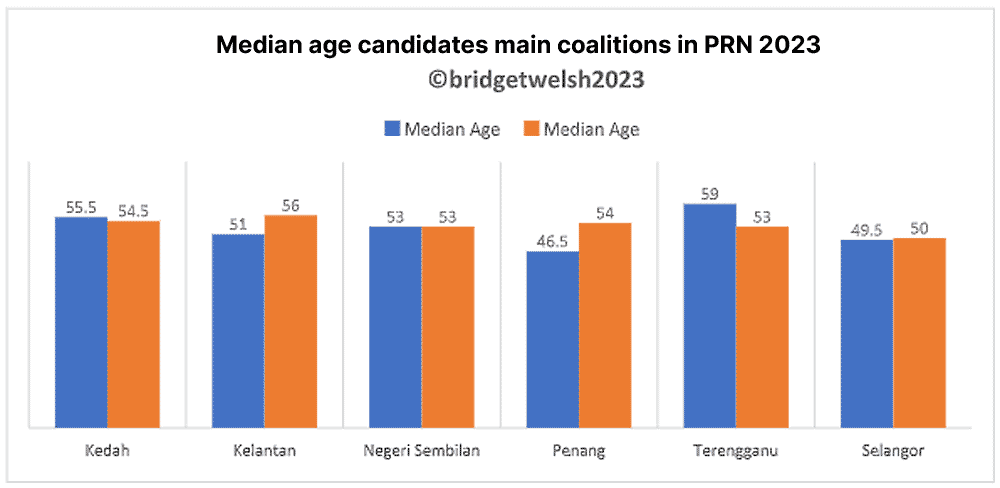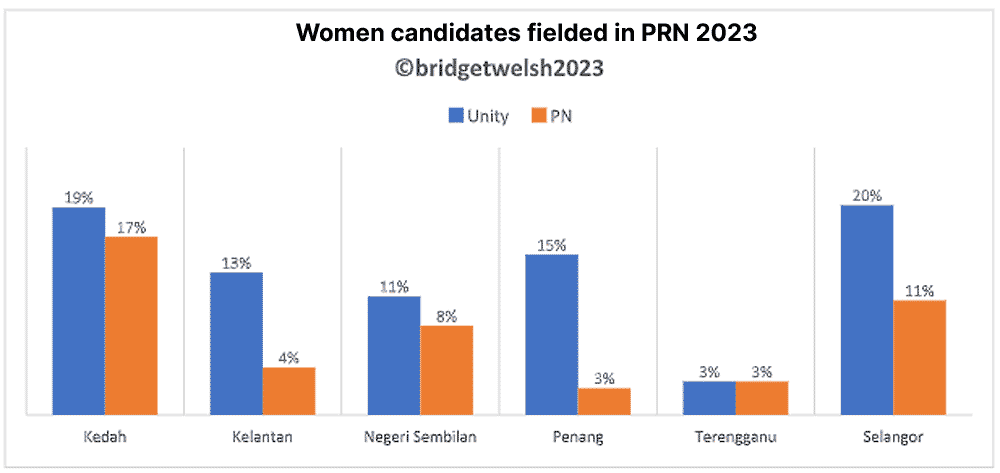This weekend, 570 candidates were slated to run in 245 seats for the upcoming state polls. Both of the two main coalitions fielded a full slate, with Muda running in 19 seats, PRM 13, PSM in four, and other parties three. There are 41 independents running.
The fielding of candidates across six states allows us to observe broader trends in how the different parties are evolving and what they are offering the electorate.
This eighth piece in my election series looks at five macro trends, drawing from previous research on candidate backgrounds. The findings are from a detailed analysis of public information about the candidates including age, ethnicity, gender, previous standing for office, and information about their backgrounds.
For incumbency and gender, the information is based on a completed data set in all seats, while for the analysis of professions, the data set is based on 65 percent of the total candidates, as there are some gaps still to be completed.
Here are the macro trends:
1. Coalitions in government opting for status quo
Incumbency is significant, especially by coalitions that hold power in individual states. Recontesting is also common, with the same candidates running in the same places again.
The most number of incumbents being fielded is in Kelantan (22 candidates or 69 percent) by PAS, followed by Penang (21 or 53 percent) and Negeri Sembilan (19 or 53 percent) by the Pakatan Harapan-BN alliance and Terengganu (17 of 53 percent) by PAS.
It is only in Kedah and Selangor where there has been more turnover, with the coalitions in power still fielding at least a third of the incumbents, 36 percent by Harapan-BN in Selangor and 33 percent by PAS in Kedah.

The opposition is offering the newest faces in Selangor from Perikatan Nasional (PN) (with only 5 percent incumbents) and Muda, whose entire slate are newcomers, although many with professional experience.
Generally, the two coalitions in government are sticking with those they know to avoid exacerbating infighting, and not removing incumbents, even some relatively poor performers. This illustrates that the parties are indeed playing it safe.
2. Politics as a profession
The major coalitions are also opting to field candidates from within political parties. The majority of the candidates are from established political organisations. Whether political secretaries, working for political parties more generally or having served in political positions, the slate on offer is comprised of people who make politics their profession.
This reflects the institutionalisation of parties and less willingness to embrace outsiders as political parties become more established, and more focused on their own in grooming and selecting potential candidates.
In Umno, the party has fielded many divisional chiefs while in Bersatu, many of its candidates are recycled politicians, largely formerly from Umno. DAP and PAS are also fielding from within.
Selangor has the most candidates with ties to political organisations or were/are politicians. This is followed by Negeri Sembilan, where Harapan-BN is overwhelmingly fielding those from within political parties. It is only in Kelantan and Terengganu where the number of politicians is lower.

3. Growing influence of religious scholars
The reason the number is lower is that these two states have large numbers of ustaz/uztazah candidates. While ustaz/uztazah candidates are also politicians, especially those serving multiple terms in government, for the purposes of analysing the role of religious scholars in politics, I treat this as its own category.
It is in Terengganu where the most number ustaz/uztazah have been fielded, a total of 15 or 47 percent, more than politicians. The number of ustaz/uztazah in Kelantan has dropped compared to the past, while elsewhere the number has increased. PAS is fielding the most number of religious scholars in keeping with the party’s ideology and leadership structure.

It is important, however, to appreciate that ustaz/uztazah candidates are being fielded across political coalitions with greater frequency.
It is also interesting that the background of those running for office is changing in other ways. The candidate list also includes some actors, football players, social media influencers, and more, as candidates from business, former civil servants, teachers, and professionals, while still important, are making up comparatively lower shares of those running for office than before.
4. Candidates in major coalitions not getting younger
What is not changing is the dominance of older candidates. While the median age in Malaysia is 30 years old, the candidates from Harapan-BN and PN are not getting any younger.
In fact, what stands out is the similarity in the median age across the major coalitions, largely in the early 50s. This is in keeping with politics becoming a profession for those in power and increasingly for those being slated to run.

While all the coalitions do field the occasional younger candidate, the number of candidates in their 20s and 30s is relatively low for the coalitions, on average less than 10 percent.
The only party that is offering a majority of younger candidates, the greatest inclusion for younger voices, is Muda. Many of the independent candidates running are also younger.
The range of ages of candidates varies in different states, over five decades in difference.

5. Marginalisation of women candidates
The issue of inclusion is also relevant to gender. Only 71 women are being fielded in these state polls, a mere 12 percent overall. For the two major coalitions, this number is 54 women (or 11 percent), 35 for Harapan-BN, and 19 for PN.
Muda is the most representative of women, fielding 10 or 53 percent women candidates.
The major coalitions are reducing the number of women being fielded compared to the past as women are facing more exclusion, including at the senior levels in the major political coalitions.

The largest share of women fielded is in Kedah, followed by Selangor. Harapan-BN generally fielded more women, as Umno and Harapan did in the past.
The share of women candidates is especially low in Terengganu, where both major coalitions only fielded one woman each.
Many of these overall trends raise concerns. The findings point to limited inclusion for women and younger candidates in established political coalitions, more candidates from inside political organisations, fewer newcomers with new ideas, with more people who are loyal to institutions.
At the same time, the candidates on offer have more experience in politics. The “play-it-safe” slates offer stability if the incumbents are chosen and those with knowledge of their jobs.
Looking at the candidate trends as a whole, however, despite highly competitive contests, voters are generally getting more of the same.- Mkini
BRIDGET WELSH is an honourary research associate of the University of Nottingham, Malaysia’s Asia Research Institute. She is also a senior research associate at the Hu Fu Centre for East Asia Democratic Studies and a senior associate fellow at The Habibie Centre. Her writings can be found at bridgetwelsh.com.
The views expressed here are those of the author/contributor and do not necessarily represent the views of MMKtT.




No comments:
Post a Comment
Note: Only a member of this blog may post a comment.